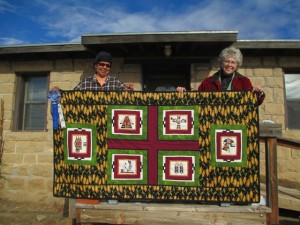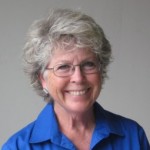
In the late 1880s, missionaries and government school teachers introduced quilting to Hopi people. Quilting was a means to teach practical skills, as well as to promote Christianity. But to the people who had always used every resource available, the stitching together of cotton scraps soon became a new art form that was integrated into their culture. Just as Anglo housewives pieced bits of fabric into quilts to keep their families warm during long winters, Hopi quilters used every piece of fabric available, from flour sacks to patches cut from old clothing. The practicality and thriftiness of quilting appealed to their ancient traditions of survival.
Quilting and sewing were new skills introduced to the women, as Hopi men had traditionally woven and sewn the blankets and garments used by their families. Missionaries held quilting sessions for the men, and also used that time to proselytize. Some Hopi men today have continued the tradition, and are especially known for their beautiful quilt blocks painted with images of kachinas. One male artist is known to stitch custom quilts for baby naming ceremonies incorporating the clan symbols of the mother and father.
With the introduction of quilting, the craft became a popular, and necessary, pastime. Quilts soon replaced rabbit-pelt robes and traditional hand-woven cotton and wool blankets. Not only did quilting become a popular skill, but quilts became tightly woven into Hopi culture and ceremony. Quilts are honored gifts at weddings, anniversaries, and graduations. Quilts are given when a family member leaves home for school, work, or military service. Gifts of quilts are an integral part of Hopi Baby Namings, a tender dawn ceremony where a Hopi clan name, along with a quilt, is given to welcome the newest member of the family and community. And, at the end of life, quilts are often used as burial shrouds or displays at memorial gatherings.

When quilting was introduced to the Hopi People, just as the skill was incorporated into daily life, so were the Anglo quilt patterns redesigned to reflect Hopi imagery. Animals that hold cultural significance, eagles, bears, rabbits, and frogs, are seen on quilts, as are plants, such as corn and tobacco. Images of kachinas, pottery, bows and arrows, and lightning sticks are painted on quilt blocks. Clan designs are also popular images on quilts. In a beautiful blending of cultural traditions, one Hopi quiltmaker pieced an Anglo quilt pattern, the Irish Chain, but hand quilted spider webs in the plain setting squares, creating a unique gift for a nephew who is a member of the Spider Clan.
Quilts now appear everywhere in Hopi villages as warm wraps for babies and bedcovers, and can be seen draped along roof tops when people gather to watch ceremonies in the plaza below. Third- and fourth-generations of Hopi quilters design and stitch quilts that reflect ancient ways blended with unique cultural motifs. Hopi quilters are talented fiber artists and their work is increasingly shown in galleries and museum exhibits. Quiltmaking has decidedly become a Hopi art and tradition.

 Carolyn O’Bagy Davis, a fourth-generation descendant of Utah pioneers, is the author of thirteen books on archaeology, quilting, and the history of the Southwest. Her book Hopi Summer was selected as OneBookArizona for 2011, and Desert Trader was named one of the Best Books of the Southwest 2012. She was the founding president of the Tucson Quilters Guild and Old Pueblo Archaeology Center and is an inducted member of the Arizona Quilters Hall of Fame and the Society of Women Geographers. Davis has appeared on HGTV, PBS, and Lifetime programs, and has curated many traveling museum exhibitions.
Carolyn O’Bagy Davis, a fourth-generation descendant of Utah pioneers, is the author of thirteen books on archaeology, quilting, and the history of the Southwest. Her book Hopi Summer was selected as OneBookArizona for 2011, and Desert Trader was named one of the Best Books of the Southwest 2012. She was the founding president of the Tucson Quilters Guild and Old Pueblo Archaeology Center and is an inducted member of the Arizona Quilters Hall of Fame and the Society of Women Geographers. Davis has appeared on HGTV, PBS, and Lifetime programs, and has curated many traveling museum exhibitions.